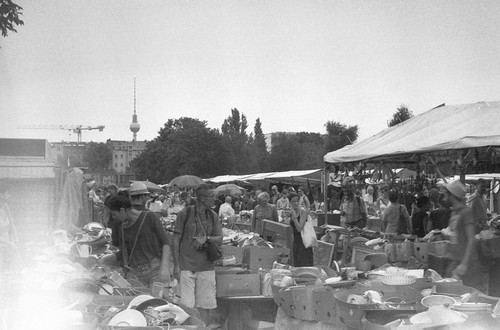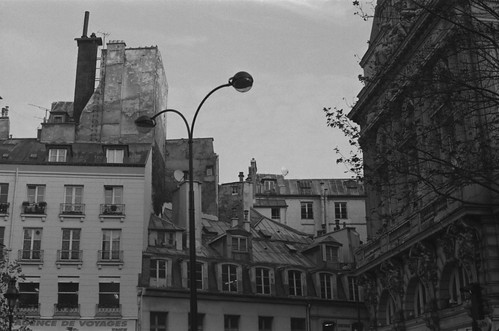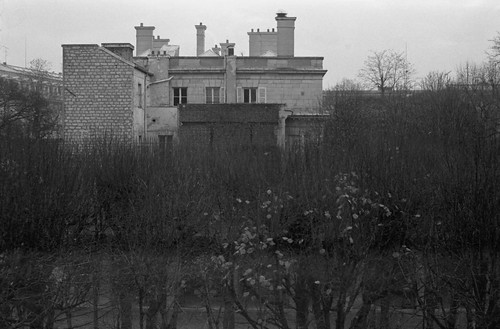When Alice and Philip alight from the Schwebebahn in Wuppertal, they find a hotel almost opposite the station entrance on Sonnborner Strasse. The girder of the Schwebebahn, which in this section is suspended above the road, lies directly outside of the window of the hotel room. A train goes past as Philip tells Alice when she has asked for a bedtime story, "I don't know any stories". Philip Winter, played by Rüdiger Vogler, in
Alice In The Cities is introduced to the audience as a writer in the first part of the film, before he meets Alice and her mother, although he has been unable to write while in America; returning to Europe with Alice appears to provide inspiration and motivation for him to write. As
Bruno Winter in
Kings Of The Road, he repairs cinema projectors; Philip Winter returns as a private detective several years later in
Until The End Of The World and
Faraway, So Close!, and finally as a sound engineer in
Lisbon Story. It might be fair to assume that Rüdiger Vogler stands in for Wim Wenders (even as a different character - to match his different occupations as Winter - in the middle film of the 'road movies trilogy',
The Wrong Move), not as an alter ego perhaps, but something of a specifically German everyman, born into the same 1940s generation as Wenders, who came of age in a divided Germany in the 1960s.
After announcing that he knew no stories, Philip relents and begins, ”Once there was a man" but after an interruption he corrects himself and starts again: "Once there was a little boy who got lost”. Each 'figure' in Philip’s story - like a musical figure - passes in succession, seemingly with only its linear sequence to connect it with the statement before, which has echoes of the structure of the road movie itself: "and then..." - "and then" Alice asks when there is a pause. This emphasises the clear
storyness of the story, its episodic motifs tumbling past each other as Philip improvises its forward movement long enough for Alice to fall asleep. The soundtrack theme by Can re-appears and Philip closes the window to mute the sound of the Schwebebahn.
Since the hugely successful
Paris, Texas, it sometimes feels that the stories are
imposed on Wim Wenders films: in contrast, with the best of his films from the 1970s, the story, or the narrative, was rather more contingent on character and location, even with those films with external sources, his 'B-films':
The American Friend's Jonathan Zimmermann in Hamburg, or Wilhelm Meister moving through 1970s West Germany in
The Wrong Move. In later films, character and location become subservient to the narrative -
Wings Of Desire being a case in point: despite its reputation, with its self-defining seriousness, it has none of the sure lightness of touch that makes
Alice In The Cities such a joy. Despite a few directorial mis-steps,
Lisbon Story, a later exception, touches these contingencies again. In recent years, Wenders is more happy as a documentarian: here, the material can be shaped from the outside, rather than from the inside in a fictional narrative.
On the train to St Petersburg nineteen months ago, as passengers' travel documents were checked by passport and customs controls, the man seated at our table, who had pronounced crossing the border, "very John le Carre", told us the bare outline of a fascintating story:
"The train stops at Vyborg. Russian customs (in green) and passport/visa control in black, with forage caps and all that we saw were female. The passenger sitting adjacent, next to T- proffered the information that he used to live here, in Vyborg, that it wasn't a very Russian city, having been Finnish and under Swedish control. [We later saw that he had a Norwegian passport and spoke fluent Russian to the customs officials.] He told us that he had met a woman about ten years ago, who was 113, living in a Soviet era apartment with her daughters, in their eighties. She had been married and had a family before the Russian Revolutions of 1917. She had been a prisoner of war [in the second world war] captured by the Germans, and had been in a camp in Kaliningrad. He said that it had been [a] German [city and he couldn't think of the name]. I was able to offer that it had been known as Königsberg. He said that she had told him at the end of the war she had walked home to Vyborg "on her own two legs". He had said he'd asked her if she had any photographs, documentation of this remarkable journey. She had said that photographs were the last thing on her mind."
Later, the man went to the buffet car saying something along the lines of the fact that one could always find better company there - I think we weren't convivial or gregarious enough fellow passengers for him. The short few sentences about the 113-year old woman were bound up with a century's worth of upheavals in ideology, history and nation states themselves. Vyborg, where the train was stopped, had been Viipuri when Finnish, which it had been when this woman would have been born in 1890. As part of the Grand Duchy of Finland, it was ruled by the Tsar, but with a relative amount of autonomy; it then became part of an independent Finland after the civil war following the revolutions of 1917. After the Winter War, the Soviets captured and annexed Vyborg; it then briefly returned to Finnish control with the Continuation War, and finally became part of the Soviet Union once again, and was recognised as such with the Moscow Peace Treaty.
The location where the woman had been held as a prisoner of war had a similarly complicated twentieth century history. Königsberg was the major city of East Prussia, and at the beginning of the century this was a contiguous part of Germany itself, seat of the Hohenzollerns who became the emperors of a united Germany. After the First World War, this became an enclave, cut off from Germany by the Polish corridor, which stretched across former Prussian lands to the Baltic Sea. At the end of the Second World War, the victorious Allies determined to simplify the map of Europe by forcing the mass migration of Germans into the redrawn boundaries of post-war Germany, a form of ethnic cleansing designed to forestall any future conflicts of expansion. East Prussia was ceded to the Soviet Union and its German identity erased. Königsberg became Kaliningrad, and by an irony of fate, with the fall of the Soviet Union, Kalinigrad Oblast became an enclave once again, remaining Russian, while now surrounded by the EU countries of Poland and Lithuania
"There is something extraordinary about the decision of the Allied control council, in February 1947, to abolish the state of Prussia by an act of law. Unlike most laws issued by the council, this one has a miniature history lesson in the preamble. It says Prussia, which had since times of yore been the seat of reaction and militarism, is hereby demolished. The explanation for the law is in its wording. The state is seen as the source of militarism and reaction in German history and for that reason it has to be exorcised from the European map. It is an unquiet spirit that must be dispelled."
Christopher Clark, quoted in Neil MacGregor, Germany: Memories of a Nation
Living in the United Kingdom, an island with 'natural' geographical borders, although with the contentions of Ireland and to a lesser degree Scotland, brings with it a sense of national identity that does not necessarily need to be questioned. It is hard therefore to imagine what it may be like to live in contested lands, especially in the last century or so of the nation state - essentially a recent concept, but one that it would be difficult to conceive of a world without: in certain parts of Europe boundaries and allegiances have changed numerous times in the last one hundred years. However, with closer integration within the EU, perhaps regional identities - within being 'European' - will begin to feel more important than national identities, much as a writer like Stefan Zweig may have felt before the outbreak of the First World War.
As light relief, in Jerome K. Jerome's Diary of A Pilgrimage, he recounts being stuck in a train carriage with a very talkative man, who tells a long story about a dog, which remained undefined by its shagginess or not, but this feels knowing:
“After the dog story, we thought we were going to have a little quiet. But we were mistaken; for, with the same breath with which he finished the dog rigmarole, our talkative companion added: “But I can tell you a funnier thing than that—” We all felt we could believe that assertion. If he had boasted that he could tell a duller, more uninteresting story, we should have doubted him; but the possibility of his being able to relate something funnier, we could readily grasp. But it was not a bit funnier, after all. It was only longer and more involved. It was the history of a man who grew his own celery; and then, later on, it turned out that his wife was the niece, by the mother’s side, of a man who had made an ottoman out of an old packing-case.”
Jerome K. Jerome, Diary of a Pilgrimage










